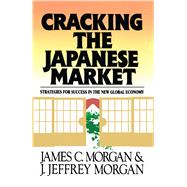
| Acknowledgments | |
| Introduction | |
| The Growing Chasm | |
| Why America Must Compete in Japan | |
| The Tools to Compete | |
| Islands in the Mist | |
| Sunrise Over the Pacific: The Japanese Challenge | |
| The Japanese Money Machine | |
| Innovators, Not Imitators | |
| Losing the Building Blocks | |
| Symptoms of a Larger Malaise | |
| The Japanese Way: Origins of a Merchant Nation | |
| Nihonjinron | |
| Poor Island Mentality | |
| A Group-oriented Society | |
| The Quest for Wa | |
| The Status Hierarchy | |
| The Power of Obligation | |
| Education: The Acid Test | |
| The Global Farmer: Inside the Japanese Market | |
| A Nation with a Mission | |
| The Command Economy | |
| The Bureaucracy | |
| Keiretsu -- The Business Elite | |
| Sogo Shosha | |
| The Banks | |
| Captive and Affiliated Suppliers and Distributors | |
| Technology Specialization | |
| Hurdles in the Japanese Market | |
| The Capitalist Animal | |
| The Customer Is God: Inside the Japanese Company | |
| Kaisha: The Corporate Family | |
| Consensus Management | |
| Toward Anshin | |
| Service as Religion | |
| The Quality Obsession | |
| The Loyal Supplier | |
| The Importance of Commitment | |
| Profile of a Salaryman | |
| Doing Business with Nihonsha | |
| Bushido: Way of the Samurai -- The Japanese as Competitors | |
| The Quiet Competitors | |
| Using Market and Trend Analysis to Nibble at the Edges | |
| From Components to Systems | |
| Burrowing, Emersion, and Knitting | |
| Deep-Pocket Commerce | |
| Japanese Strategy in Action | |
| The Future: Kokusaika and Inobeshion | |
| The Japanese Success Quotient: American Companies in Japan | |
| Characteristics of Winners in Japan | |
| Revering the Customer as God | |
| Controlling Your Own Destiny | |
| Researching and Manufacturing the Right Product for Japan | |
| Building a World-Class Organization and Management | |
| Embracing Cooperation and Competition | |
| Ningen Kankei -- Human Relations | |
| Getting Back to Basics | |
| The Attack/Counterattack Response | |
| Emphasizing Similarities/Taking Advantage of Differences | |
| Believing that Success in Japan Leads to Global Excellence | |
| Applied Materials Japan: A Brief History of a Long Journey | |
| Innocents Abroad | |
| Applied Materials Japan | |
| Growth and Competition | |
| A Breakthrough | |
| The Narita Technology Center | |
| The 'Tough Old Samari'Hard Times in Tokyo | |
| Succeeding in Japan | |
| Kick-Starting the Global Organization | |
| Seeing Beyond America | |
| Study the Japanese Market | |
| Make a Company-Wide Commitment to Japan | |
| Develop a Japanese Market Philosophy | |
| Presence and People | |
| Pioneering | |
| Piggybacking | |
| Partnering | |
| Persistence | |
| Other Considerations in Market Strategy | |
| Defining the Japan Strategy | |
| The Market Map | |
| Modes of Entry into Japan | |
| The Distribution Agreement | |
| The Licensing Agreement | |
| The Joint Venture Agreement | |
| Selecting a Partner | |
| The Power of Cooperation | |
| Negotiating for Partnership | |
| A Word about Mergers and Acquisitions | |
| Global Partnership Model | |
| The Japanese Subsidiary | |
| Growing the Japanese Business | |
| People | |
| Facilities | |
| Systems | |
| Financing | |
| Becoming an Insider in Japan | |
| Becoming a World-Class Competitor | |
| Testing Your I.Q. (International Qualities) | |
| The Global Vision | |
| The Global Company Model | |
| Lessons from Japan on World-Class Competitiveness | |
| Continuous, Incremental Improvement | |
| Empowering the Workforce | |
| Building Customer Linkages | |
| Effectively Using External Resources | |
| Cost-Effective Product | |
| Design and Delivery Infrastructure | |
| Superior Information Systems | |
| Long-Term Thinking and Commitment | |
| Challenge and Opportunity: The Keys to Success in Japan | |
| A Realistic View of the Japanese Challenge | |
| The Keys to Success in Japan | |
| Shobai wa Akinai -- 'Never Give Up'The Time to Win in Japan Is Now | |
| The Golden Age of Global Growth | |
| Afterword: The America That Can Compete | |
| What America Can Do | |
| What Japan Can Do | |
| A Bright Shining Future | |
| Appendix A | |
| Appendix B | |
| Appendix C | |
| Table of Contents provided by Publisher. All Rights Reserved. |
The New copy of this book will include any supplemental materials advertised. Please check the title of the book to determine if it should include any access cards, study guides, lab manuals, CDs, etc.
The Used, Rental and eBook copies of this book are not guaranteed to include any supplemental materials. Typically, only the book itself is included. This is true even if the title states it includes any access cards, study guides, lab manuals, CDs, etc.